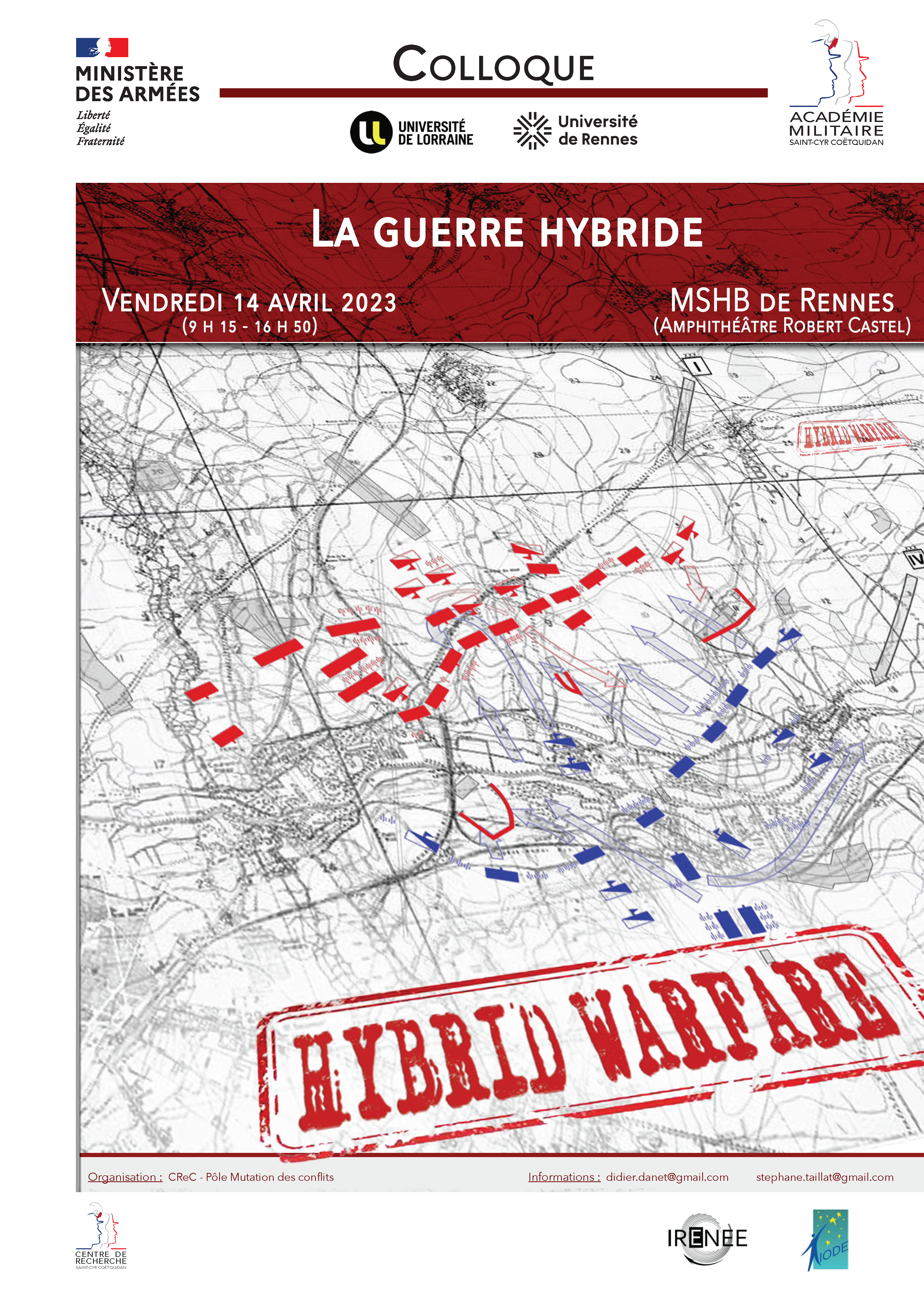The Human Factor in the Geopolitics of the Internet.
Continue readingUkraine : pourquoi la cyberguerre ne s’est pas passée comme prévu — Kevin Limonier dans Mediapart
Ukraine : pourquoi la cyberguerre ne s’est pas passée comme prévu — Kevin Limonier dans Mediapart
Mediapart
30 mars 2023
Auteur

Kevin Limonier, maître de conférences en études slaves et en géopolitique à l’Université Paris 8 et directeur adjoint de GEODE, s’est entretenu avec Mediapart au sujet des manoeuvres cybernétiques russes en Ukraine. Il revient, en particulier, sur la manipulation des routes de l’Internet par la Russie.
« Le chercheur Kevin Limonier explique pourquoi l’invasion de l’Ukraine n’a pas été accompagnée d’attaques spectaculaires sur les infrastructures numériques. Il détaille, surtout, comment la Russie est passée maîtresse dans un autre domaine : la manipulation des routes de l’Internet. »
Frédérick Douzet obtient une bourse ERC de 2,5 millions d’euros pour son projet sur la géopolitique des routes de l’Internet
Frédérick Douzet obtient une bourse ERC de 2,5 millions d’euros pour son projet sur la géopolitique des routes de l’Internet
30 mars 2023

Excellence scientifique à l’université Paris 8.
Frédérick Douzet lauréate de la prestigieuse bourse du Conseil Européen de la Recherche (ERC) dans la catégorie Advanced pour un budget de 2,5 millions d’euros.
Frédérick Douzet, Professeure des Universités à l’Institut Français de Géopolitique de l’université Paris 8 et directrice du centre GEODE (Géopolitique de la Datasphère) vient d’obtenir une bourse du Conseil Européen de la Recherche (ERC) dans la catégorie Advanced pour son projet DATAROUTES qui vise à cartographier les routes de l’Internet et leur manipulation à des fins stratégiques. Ce programme de financement de la recherche est l’un des plus prestigieux et des plus compétitifs de l’Union Européenne (UE). Il vient, pour la première fois, récompenser l’excellence de la recherche en sciences humaines et sociales menée à l’université Paris 8.
A l’annonce des résultats, Frédérick Douzet s’est réjouie : “Je suis très heureuse de l’obtention de cette bourse qui va me donner les moyens de mener à bien un projet de recherche ambitieux qui s’inscrit pleinement dans l’esprit d’innovation et d’expérimentation en sciences sociales de l’université Paris 8. Ce projet s’appuie sur près de 10 ans d’investissement dans la construction d’une conversation interdisciplinaire exigeante menée au sein de l’Institut Français de Géopolitique et du projet GEODE, que je dirige. Je tiens à remercier chaleureusement toute mon équipe pour son soutien indéfectible mais aussi les nombreux collègues, amis et personnels des services de Paris 8 qui m’ont aidée à préparer ce beau projet et surtout m’entraîner pour l’épreuve orale”.
Annick Allaigre, présidente de l’université, salue la performance de Frédérick Douzet, qui décroche avec ce projet particulièrement pertinent au regard de l’actualité internationale, fruit d’un travail acharné et d’une capacité à fédérer une équipe de premier plan, la première ERC de l’université Paris 8. Cette réussite reflète aussi la qualité de l’accompagnement par les services de la recherche de projets de très haut niveau et vient récompenser une politique résolue de soutien à la recherche.
Arnaud Regnauld, vice-président recherche de l’université ajoute : “Le projet DATAROUTES s’inscrit dans le prolongement d’une dynamique scientifique ambitieuse portant sur la « Géopolitique de la Datasphère » (GEODE), projet élaboré par l’IFG Lab. L’obtention de cet ERC marque la reconnaissance des travaux engagés par Frédérick Douzet et son équipe et témoigne de l’excellence et du rayonnement de ce laboratoire en matière de recherche exploratoire à l’échelle internationale”.
Comprendre comment les Etats et les acteurs non-étatiques façonnent le cyberespace en cherchant à contrôler les routes empruntées par les données numériques
L’Internet a pu se développer très rapidement dans la plupart des pays grâce à sa nature fortement décentralisée. Sa résilience repose sur une multiplicité de chemins différents qui permettent aux données de toujours contourner un blocage ou une destruction partielle du réseau par des voies alternatives. Ce modèle est aujourd’hui remis en cause par deux grandes dynamiques d’évolution. D’une part, certains États, au nom de la sécurité nationale, cherchent à rétablir le contrôle sur les frontières de ce qu’ils considèrent comme leur cyberespace national, créant une fragmentation le long des frontières étatiques. D’autre part, à un niveau d’abstraction plus élevé, on observe une autre dynamique, guidée cette fois par les forces du marché : la concentration du trafic de données autour de quelques acteurs majeurs de l’acheminement des données et de quelques grandes plateformes, comme les GAFAM. Largement invisible, cette concentration conduit également à une forme de fragmentation selon des lignes commerciales.
Ces évolutions soulèvent des questions majeures en termes de stabilité et de résilience de l’Internet, de libre circulation des données et de droits de l’homme. Le projet DATAROUTES vise à construire une cartographie des chemins empruntés par les données numériques pour comprendre comment et avec quelles conséquences les stratégies de contrôle des acteurs façonnent le cyberespace et analyser les enjeux majeurs en termes de sécurité et de politiques publiques pour l’Union européenne.
La reconnaissance de l’excellence scientifique des recherches menées à l’Université Paris 8.
Le programme de bourses ERC Advanced s’inscrit dans le cadre du programme Horizon Europe. Ces bourses sont accordées à des chercheurs confirmés et reconnus dans leur domaine aux niveaux national et international. Elles permettent de mener des projets ambitieux et novateurs à haut risque pouvant déboucher sur des avancées scientifiques majeures. D’une durée de 5 ans, les projets financés bénéficient chacun d’un budget maximum de 2,5 millions d’euros.
Sur 1 650 candidatures reçues, l’ERC distingue cette année 218 lauréats dans la catégorie Advanced, soit un taux de succès de 13,2%. Avec 32 projets lauréats, la France se classe troisième parmi les 20 pays d’Europe représentés, derrière l’Allemagne et le Royaume Uni.
Le projet DATAROUTES permettra le recrutement de plusieurs doctorants, post-doctorants et ingénieurs de recherche qui seront hébergés sur le Campus Condorcet, dont l’université Paris 8 est membre.
Déjà reconnus par l’Institut Universitaire de France (IUF), les travaux de Frédérick Douzet s’inscrivent dans les recherches innovantes menées au sein du projet GEODE, labellisé en 2020 “Centre d’Excellence Relations Internationales et Stratégie” par le Ministère des armées et financé par la Fondation William et Flora Hewlett. Cette bourse vient également récompenser les équipes de l’Institut Français de Géopolitique de l’université Paris 8 auquel le centre GEODE est rattaché. Elle témoigne enfin de la vitalité et de la nécessité des recherches interdisciplinaires en sciences humaines et sociales menées au sein de l’Université Paris 8 pour faire progresser les connaissances.
>> Télécharger le communiqué de presse <<
Colloque guerre hybride – 14 avril
Colloque guerre hybride – 14 avril
Continue readingLa souveraineté numérique de la Russie en 3 questions avec Marie-Gabrielle Bertran
La souveraineté numérique de la Russie en 3 questions avec Marie-Gabrielle Bertran
Continue readingLa recherche de son autonomie stratégique numérique par l’Union européenne : Réflexions de droit international – Article d’Aude Géry dans la Revue de l’Union européenne
La recherche de son autonomie stratégique numérique par l’Union européenne : Réflexions de droit international – Article d’Aude Géry dans la Revue de l’Union européenne
Revue de l'Union européenne
6 mars 2023
Auteur

Aude GERY, chercheuse GEODE et docteure en droit international, a contribué au nouveau numéro de la Revue de l’Union européenne avec un article intitulé « La recherche de son autonomie stratégique numérique par l’Union européenne : Réflexions de droit international », co-écrit avec Esther Noël. Leur article explore l’impact de la politique de l’UE sur les données personnelles, l’intelligence artificielle et la cybersécurité, ainsi que son rôle dans l’ordre juridique international.
Comment Israël s’est imposé en tant que «cyberpuissance» — Ilan Scialom pour RFI
Comment Israël s’est imposé en tant que «cyberpuissance» — Ilan Scialom pour RFI
RFI
6 mars 2023
Auteur
Découvrez dès maintenant les analyses d’Ilan Scialom sur l’ascension d’Israël en tant que cyberpuissance et son impact sur la géopolitique de la région.
« Le scandale Pegasus et le projet Storykillers ont récemment révélé les agissements de sociétés israéliennes dans le domaine du cyberespionnage et de la cybersécurité. Un secteur dans lequel l’État hébreu est devenu un pôle incontournable. Mais comment expliquer que ce petit pays de 9 millions d’habitants soit devenu, en quelques décennies, un acteur majeur dans ce domaine ? »
Espionnage : pourquoi TikTok fait tiquer – Citations de Julien Nocetti dans Libération
Espionnage : pourquoi TikTok fait tiquer – Citations de Julien Nocetti dans Libération
Libération
6 mars 2023
Auteur

Le réseau social chinois TikTok est-il vraiment un « cheval de Troie » de Pékin ? Découvrez les analyses percutantes de Julien Nocetti, chercheur à GEODE et à l’Ifri – Institut français des relations internationales, dans l’article du journal Libération « Espionnage : pourquoi TikTok fait tiquer ».
MATHIEU Paul
Data scientist
Continue readingROSA-MARTIN Antonin
Datascientist
Continue reading










